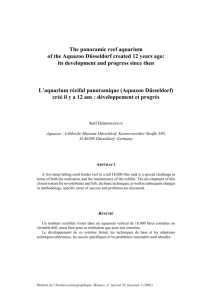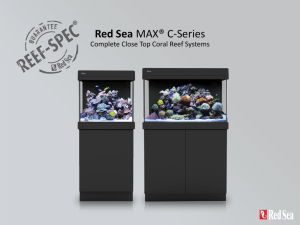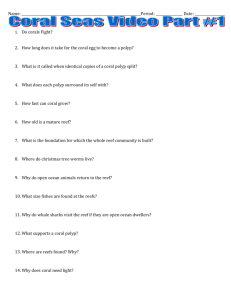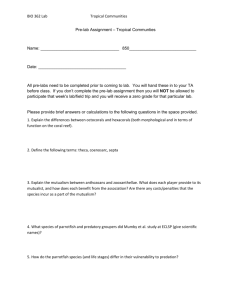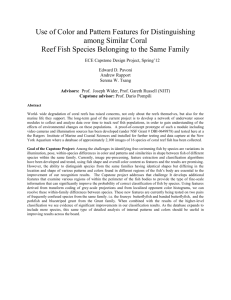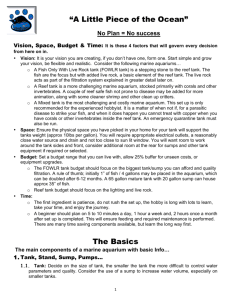File
advertisement
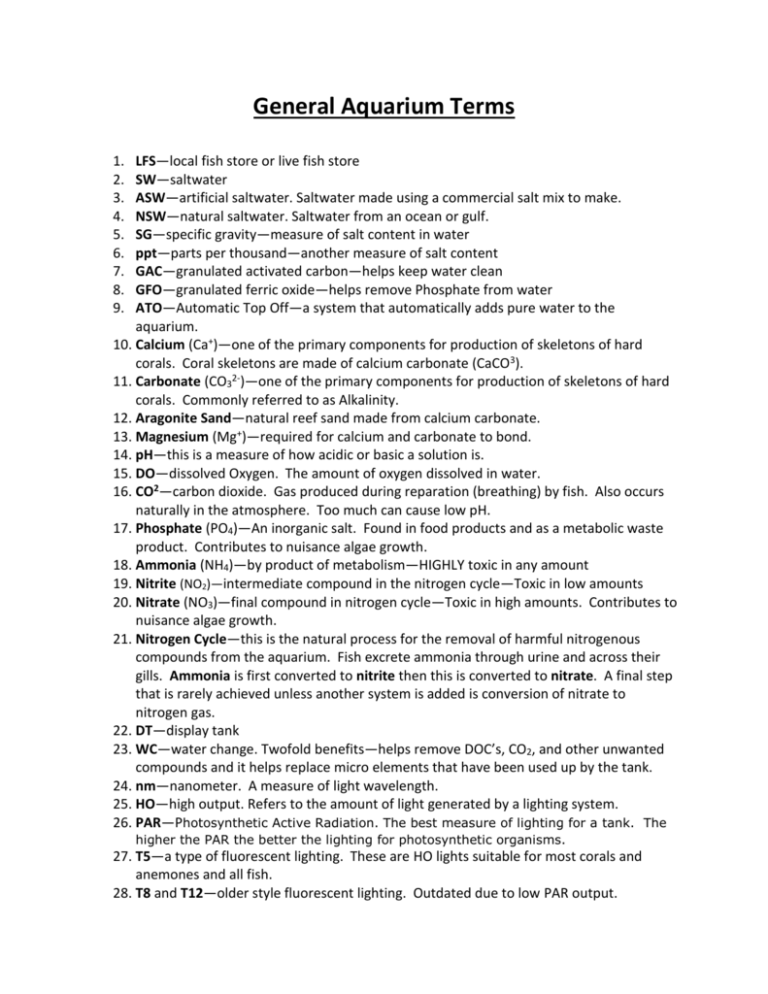
General Aquarium Terms 1. 2. 3. 4. 5. 6. 7. 8. 9. LFS—local fish store or live fish store SW—saltwater ASW—artificial saltwater. Saltwater made using a commercial salt mix to make. NSW—natural saltwater. Saltwater from an ocean or gulf. SG—specific gravity—measure of salt content in water ppt—parts per thousand—another measure of salt content GAC—granulated activated carbon—helps keep water clean GFO—granulated ferric oxide—helps remove Phosphate from water ATO—Automatic Top Off—a system that automatically adds pure water to the aquarium. 10. Calcium (Ca+)—one of the primary components for production of skeletons of hard corals. Coral skeletons are made of calcium carbonate (CaCO3). 11. Carbonate (CO32-)—one of the primary components for production of skeletons of hard corals. Commonly referred to as Alkalinity. 12. Aragonite Sand—natural reef sand made from calcium carbonate. 13. Magnesium (Mg+)—required for calcium and carbonate to bond. 14. pH—this is a measure of how acidic or basic a solution is. 15. DO—dissolved Oxygen. The amount of oxygen dissolved in water. 16. CO2—carbon dioxide. Gas produced during reparation (breathing) by fish. Also occurs naturally in the atmosphere. Too much can cause low pH. 17. Phosphate (PO4)—An inorganic salt. Found in food products and as a metabolic waste product. Contributes to nuisance algae growth. 18. Ammonia (NH4)—by product of metabolism—HIGHLY toxic in any amount 19. Nitrite (NO2)—intermediate compound in the nitrogen cycle—Toxic in low amounts 20. Nitrate (NO3)—final compound in nitrogen cycle—Toxic in high amounts. Contributes to nuisance algae growth. 21. Nitrogen Cycle—this is the natural process for the removal of harmful nitrogenous compounds from the aquarium. Fish excrete ammonia through urine and across their gills. Ammonia is first converted to nitrite then this is converted to nitrate. A final step that is rarely achieved unless another system is added is conversion of nitrate to nitrogen gas. 22. DT—display tank 23. WC—water change. Twofold benefits—helps remove DOC’s, CO2, and other unwanted compounds and it helps replace micro elements that have been used up by the tank. 24. nm—nanometer. A measure of light wavelength. 25. HO—high output. Refers to the amount of light generated by a lighting system. 26. PAR—Photosynthetic Active Radiation. The best measure of lighting for a tank. The higher the PAR the better the lighting for photosynthetic organisms. 27. T5—a type of fluorescent lighting. These are HO lights suitable for most corals and anemones and all fish. 28. T8 and T12—older style fluorescent lighting. Outdated due to low PAR output. 29. MH—metal halide. Very intense lighting best for hard corals. Generate a lot of heat so chillers and fans may be needed. High energy usage Gives natural “shimmer” effect in tank 30. LED—light emitting diode. Next generation of lighting. High output like MH but without heat or energy usage. 31. Actinic—a blue “color” of lighting that is very beneficial to photosynthetic organisms. Usually found around 420nm. 32. Kelvin or Color Temperature—a term describing the perceived color of an object based upon its heated color using the Kelvin temperature scale. Ex. 20,000K is blue, while a 3,500K is more yellow. 33. PC—Power Compact. Another type of HO fluorescent but not as good as T5. 34. DOC—Dissolved Organic Compounds. Food and fish waste. 35. RO/DI—Reverse osmosis/ de-ionized water. Pure water. The best and only water that should be used for a SW tank. 36. HOB—hang-on-back. Refers to equipment that hangs onto the back of the DT. Can be any number of items including protein skimmers or overflow boxes. 37. GPH—Gallons Per Hour. Measure of water flow rate. 38. Overflow Box—can be integrated or HOB. Allows DT water to exit the system to a sump area. Integrated styles are usually located in the corner (s) or along the back of the DT. Rated in GPH 39. Sump—a separate tank usually located under the DT used to house several pieces of equipment for aesthetic purposes. More importantly though, it allows for greater system water volume and can be used as an area for nutrient export. Most skimmers are located here along with heaters, dosing pumps and ATO systems. 40. Protein Skimmer (skimmer)—a mechanical device used to eliminate DOC from the tank. It works by mixing micro-bubbles and water. The DOC “stick” to the bubble and are carried to the top to a collection cup for disposal. Can be HOB or in sump. 41. Power Heads—a mechanical device used to create water movement in the DT. Rated in GPH. 42. Macro Algae (macro)—a multicellular algae that is allowed to grow because it uses excess nutrients and thus removes them from the DT. 43. Refugium (fuge)—an area separate from the DT, usually in the sump that serves a dual purpose. It provides a location to grow macro and also provides a safe location to grow beneficial microorganisms such as copepods. 44. FOWLR—Fish Only With Live Rock. A DT with little or no coral. A non-mixed reef tank. 45. Reef Tank—A DT with only corals and other invertebrates. 46. Mixed Reef Tank—a DT that has corals, fish and other invertebrates. 47. CUC—Clean Up Crew. Collective term for various types of snails, crabs and other invertebrates that help keep the DT clean by eating detritus, excess food and nuisance algae’s. 48. Hard Corals—A type of corals that grow a hard external skeleton made from CaCO3. Two main types. 49. SPS—Small Polyp Stony corals. A type of hard coral that has small feeding polyps. Require pristine water quality along with high water flow and intense lighting. 50. LPS—Large Polyp Stony corals. A type of hard coral that has large feeding polyps. Require high water quality, water flow and lighting, but not as much as SPS. 51. Soft Corals (Softies)—A type of corals that have no external hard skeleton. Water quality, water flow and lighting requirements are much less than the hard corals. 52. Biological Filtration—process of cleaning DT water by utilizing the nitrogen cycle. This is done by the bacteria found on live rock. The most preferred method of SW tank filtration. 53. Live Rock (LR)—A rock that is considered live because it will be colonized with naturally beneficial bacteria. These bacteria carry out the nitrogen cycle. Generally the more porous, the better. Some LR may come with lots of extra life such as macro algae and corals. Several types: man-made aquacultured, aquacultured, and natural. 54. Live Sand (LS)—Generally 100% aragonite sand that has naturally occurring bacteria on it. It helps with the removal of waste products through the nitrogen cycle and by the decomposition of detritus. 55. Mechanical Filtration—Generally not used in SW tanks due to build up of detritus on filter media which can result in high nitrates. Can be used to remove large particulate material from the water however. If used regular cleaning is a must. 56. Chemical Filtration—a secondary process of cleaning DT water. This method uses GFO and GAC to remove chemicals, toxins and other unwanted items from the water. Used in conjunction with Biological filtration and the use of a protein skimmer. 57. Tank “Cycle” (Cycle)—The time/process for a new tank to establish the bacteria that is needed to provide and sustain the nitrogen cycle. Can last 4-8 weeks. 58. RR—Reef Ready. A tank that has overflow box (es) already installed. This type of tank must be used with a sump. 59. GHA—Green Hair Algae. A nuisance algae that can take over a tank. Often found in new tanks. Thrives in high nutrient tanks. Difficult to remove. 60. Brown Diatoms (brown algae, toms)—a diatomaceous algae that appear in EVERY new tank. Will die out on its own. Utilizes silicates to make its shell. 61. Cyanobacteria (Cyano, red slime)—actually a nuisance bacteria that thrives in high nutrient/ low flow areas. While this list is by no means complete it is a starting place. Below are some online resources to further your knowledge. Also, more importantly visit some of the local aquarium stores and ask help there. Another list of aquarium books--http://www.athiel.com/html/library2.htm Aquahub—very affordable ATO system--http://www.aquahub.com/store/index.html Aquarium Pest Identifier--http://www.xtalworld.com/Aquarium/hitchfaq.htm Asira.org—good online research resource--https://sites.google.com/a/asira.org/www2/home Bulk Reef Supply—excellent online vendor--http://www.bulkreefsupply.com/store/ Explaination of lighting etc.--http://members.misty.com/don/f-spec.html Fish Lore Forum--http://www.fishlore.com/SaltwaterAquariumSetup.htm Foster and Smith dry goods--http://www.fosterandsmithaquatics.com/fish-supplies/pr/c/3578 Foster and Smith Live Animals--http://www.liveaquaria.com/FFExpress/ Gulf View Live Rock—excellent product--http://www.gulf-view.com/ Home of Reef Octopus—excellent products--http://coralvue.com/ Listing of aquarium books--http://www.saltcorner.com/AquariumLibrary/browsesection.php Louisiana Reef Club-- http://www.lareefclub.com/ Marine Depot—very good online vendor--http://www.marinedepot.com/ Melevs Reef resource for sumps--http://www.melevsreef.com/index.html Mobile Area Reef Keepers-- http://www.mbrk.com/ Modern Reef Keeping--http://modernreefkeeping.com/ Mr. Saltwater Tank-- http://www.mrsaltwatertank.com/ Pet Store.com—very good online vendor--http://www.petstore.com/ Reef Central-- http://www.reefcentral.com/forums/forumdisplay.php?f=104 Reef Chemistry Calculator--http://reef.diesyst.com/chemcalc/chemcalc.html Reefkeeping Magazine--http://www.reefkeeping.com Saltwaterfish.com Forum--http://forums.saltwaterfish.com/ Tons of lighting information--http://www.epanorama.net/links/lights.html#fluorescent Website for coral id and information-- http://sdmas.com/corals/species.php
